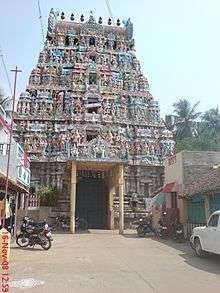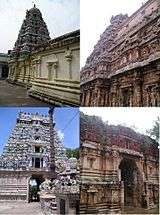Kasi Viswanathar Temple, Kumbakonam
Kasi Viswanathar Temple, Kumbakonam (காசி விஸ்வநாதர் கோயில், கும்பகோணம்)[1] is a Hindu temple dedicated to the deity Shiva, located in Kumbakonam, Tamil Nadu, India. Shiva is worshipped as Kasi Viswanathar, and is represented by the lingam. His consort Parvati is depicted as Visalakshi. The presiding deity is revered in the 7th century Tamil Saiva canonical work, the Tevaram, written by Tamil saint poets known as the nayanars and classified as Paadal Petra Sthalam.[2]
| Kasi Viswanathar Temple | |
|---|---|
Kudanthai Karonam | |
 | |
| Religion | |
| Affiliation | Hinduism |
| District | Tanjore |
| Deity | Kasi Viswanathar (Shiva) Visalakshi (Parvathi), Nava Kannigas |
| Features |
|
| Location | |
| Location | Kumbakonam |
| State | Tamil Nadu |
| Country | India |
 Location in Tamil Nadu | |
| Geographic coordinates | 10°57′23.86″N 79°22′55.92″E |
| Architecture | |
| Type | Dravidian architecture |
The temple complex covers two acres and is located close to the Mahamaham tank. It houses two gateway towers known as gopurams. The tallest is the western tower, with seven stories and a height of 72 feet (22 m). The temple has numerous shrines, with those of Kasi Viswanathar, Visalakshi and Navakanniyar being the most prominent.
The temple has six daily rituals at various times from 6:00 a.m. to 9 p.m., and twelve yearly festivals on its calendar. The Masi Magam festival is celebrated during the day of the Magam (February - March) is the most prominent festival.
The present masonry structure was built during the Nayak during the 16th century. In modern times, the temple is maintained and administered by the Hindu Religious and Charitable Endowments Department of the Government of Tamil Nadu.
Architecture
The temple is located near the banks of Mahamaham tank. This temple has two prakarams (outer courtyard) and a 72 ft high Rajagopuram. The temple has a nava kanniyar aka nava kannigais (Nine rivers) in the form of deities worshipping Lord Shiva and hence the temple is referred as 'Nava Kanniyar' temple.The nine river deities depicted are Ganges, Yamuna, Narmada, Saraswati, Cauvery, Godavari, Krishna, Tungabhadra and Sarayu. The lingam worshipped by Rama is located in the north eastern prakaram (outer courtyard) of the temple. As per local legend, he lingam is believed to grow with time.[3]
Legend
This place has been referred to in thevaram written by Saint Poet (7th Century AD) Thirugnana Sambanthar and Thirunavukkarasar.[4] This temple is referred back to Ramayana period when Lord Rama and Lakshmana are said to have worshipped Shiva here during their search for Sita, and acquired Rudramsam, to enable them to fight Ravana. Legend has it that the nine sacred rivers of India, prayed to Shiva at Banares (Viswanathar) to be absolved of the sins washed away by bathers, and were directed to bathe in the Mahamagam tank and worship Adi Kumbeswarar Temple. Viswanathar of Kaasi is believed to have manifested himself here at Kumbhakonam at Kudandaikkaronam.[5]
Specialty
12 Shiva temples are connected with Mahamaham festival which happens once in 12 years in Kumbakonam. They are :
- Kasi Viswanathar Temple,
- Kumbeswarar Temple,
- Someswarar Temple,
- Nageswara Temple,
- Kalahasteeswarar Temple,
- Gowthameswarar Temple,
- Kottaiyur Kodeeswarar temple
- Amirthakalasanathar Temple,
- Banapuriswarar Temple,
- Abimukeswarar Temple, Kumbakonam,
- Kambatta Visvanathar Temple and
- Ekambareswarar Temple.
This temple is one among them.[6]
Worship and religious practises

The temple priests perform the puja (rituals) during festivals and on a daily basis. The temple rituals are performed six times a day; Kalasanthi at 6:00 a.m., Irandam Kalm at 9:00 a.m., Uchikalam at 12:00 a.m., Sayarakshai at 6:00 p.m, Irandam Kalm at 7:30 p.m., and Arthajamam at 9:00 p.m.. Each ritual comprises four steps: abhisheka (sacred bath), alangaram (decoration), naivethanam (food offering) and deepa aradanai (waving of lamps) for Viswanathar and Visalakshi. There are weekly rituals like somavaram (Monday) and sukravaram (Friday), fortnightly rituals like pradosham, and monthly festivals like amavasai (new moon day), kiruthigai, pournami (full moon day) and sathurthi. Masi Maham during the Tamil month of Maasi (February - March), Shivaratri in February- March and Panguni Uthiram during Panguni are the major festivals celebrated in the temple.[5]
References
- ta:கும்பகோணம் காசி விஸ்வநாதர் கோயில்
- Census of India, 1961, Volume 7. Director of Census publication. 1961.
- V., Sriram (12 February 2016). "Mahamkhaam history". The Hindu.
- "Campantar Tevaram -2" (PDF). projectmadurai.org. 2011. Retrieved 16 July 2011.
- "Sri Kasi Viswanathar temple temple". Dinamalar. 2014. Retrieved 24 November 2015.
- Mahamaham Festival 2004 (in Tamil), Hindu Religious and Charitable Endowments Administration Department, Government of Tamil Nadu, 2004
External links
| Wikimedia Commons has media related to Kasi Viswanathar Temple, Kumbakonam. |








